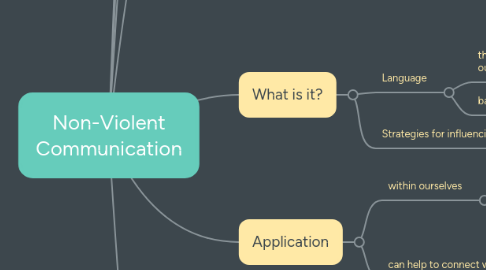
1. that helps us to communicate what would make more wonderful for ourselves
2. Marshall B. Rosenberg
2.1. grew up in Detroit/Michigan, race riots 1943 -> exposed to violence
2.2. was around people who were caring, compassionate -> knew that violence was not our nature
2.3. Saw: compassionate nature, but something makes us violent in certain circumstances.
2.4. Spent his career studying this.
2.4.1. PhD in Clinical Psychology: view of violence as a mental illness
2.4.2. learned: illness is a poor analogy: people are educated towards violence by the culture in which they live
2.4.3. what is needed is not therapy, but different kind of education
2.4.4. ... education into thinking that contributes to compassionate giving
3. What blocks communication?
3.1. Moralistic judgements: rightness/wrongness
3.1.1. increases defense & resistance
3.1.2. if people concur, then likely out of fear/shame/guilt
3.1.3. diminished goodwill
3.1.4. decreases the likelihood of a compassionate response in the future
3.1.5. judging isn't bad per se, but in NVC, judging is from a standpoint: is this behavior serving life or not?
3.2. Making comparisons between ourselves and other people
3.2.1. blocks compassion for self & others
3.3. Denial of responsibility
3.3.1. clouds our awareness that we are each respnsible for our own thought, feelings and actions
3.3.2. doesn't make life very enjoyable
3.3.3. obedient, docile people may be a dominant factor in increasing violence
3.3.4. examples
3.3.4.1. - attributing behavior to vague impersonal forces: expressions: "have to", "makes me feel ..."
3.3.4.2. - attributing our behaviour to our history: " ... because I'm an alcoholic", " ... because of my childhood ..."
3.3.4.3. - attributing to the behavior of others: "I did ... because he ..."
3.3.4.4. - attributing to the dictates of authority: "I lied because the boss told me to"
3.3.4.5. - attributing to group pressure: "because all of my friends did ..."
3.3.4.6. - attributing to policies, rules, regulations: "... because it's policy of our organization"
3.3.4.7. - blaming gender/social roles: "I hate work, but I do it because I'm a husband/father"
3.3.4.8. - blaming uncontrollable impulses: "I was overcome by my urge"
3.4. Communicating desires as demands
3.4.1. threatens with blame & punishment (explicitly or implicitly)
3.4.2. conept: certain actions merit reward, others merit punishment
3.4.2.1. "deserve"
3.4.2.2. people should change not to avoid punishment, but because they see the change in helping them to enrich life
3.4.3. is punishment an effective strategy?
3.4.3.1. ... if we only ask: what do we want other people to do differntly?
3.4.3.2. ... but we should add: what do we want their reasons to be for doing what we are asking for?
3.4.3.3. -> we want people to do things because of intrinsic values, not because of extrinsic rewards
4. Application
4.1. within ourselves
4.1.1. learn from our limitations without losing self-respect
4.2. can help to connect with others
4.2.1. close poeple
4.2.2. resolving disputes
4.2.3. to alter structures we live in towards compassionate giving
5. 2 Important Dimensions
5.1. Purpose
5.1.1. To help us connect with ourselves and others in a way that makes compassionate giving natural
5.1.1.1. compassionate giving = to do something for ourselves/others, where our soul intention is to enrich life
5.1.1.2. To get everyone's needs met compassionately
5.2. Process
5.2.1. Idea
5.2.1.1. focuses on 2 questions
5.2.1.1.1. What's alive in us?
5.2.1.1.2. What would make life more wonderful?
5.2.1.2. Helps us communicate those two.
5.2.1.3. Helps us to receive that information from others.
5.2.1.3.1. No matter how that person is communicating.
5.2.2. Mechanics
5.2.2.1. Observations
5.2.2.1.1. don't mix up observation & evaluation
5.2.2.1.2. specific to time and context
6. What is it?
6.1. Language
6.1.1. that helps us to connect with ourselves/others
6.1.2. based on feelings & needs
